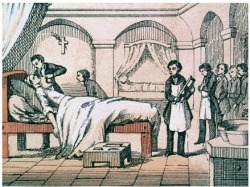In the 18th century surgery was the always the last desperate resort. Doctors and dentists had never liked the agonized screams and yells of their patients and it hurt to see them that way. The doctors and dentists had straps to secure their patients in before surgery. Some doctors gave their patients some alcohol to drink before preceding the surgery.
Healers attempted to induce a psychological state of anesthesia by mesmerism or hypnosis. But by 1846 alcohol and opium were the only agents which continued to be regarded as practical value in diminishing the pain of operations. Unfortunately, the large doses of alcohol needed to produce stupefaction were likely to cause nausea, vomiting, and death sometimes instead of sleep. Opium, still a stronger analgesic, had significant side effects itself and was typically not powerful enough to completely blunt a surgical stimulus.

The Hey’s saw, used to make an aperture in the skull to relieve pressure on the brain, was a stock item in most surgical field kits for years before the advent of effective anesthesia.
The first use of ether as an anesthetic during an operation was claimed by Crawford W. Long of Georgia in 1842. The operation, though, was unrecorded, so official credit went to Massachusetts dentist William Morton for his 1846 public demonstration of an operation using ether performed in a Boston hospital. While Morton administered the gas to the patient through an inhaling device, John C. Warren removed neck tumor without the patient feeling any pain. Following this discovery, the use of ether as an anesthetic, general anesthesia began to be practiced all over the United States and Europe.
Chloroform was introduced as a surgical anesthetic by Scottish obstetrician James Young Simpson in 1847. After first experiment with ether, Simpson searched for an anesthetic that would make childbirth less painful for women. Although it eased the pain of labor, chloroform had higher risks than those associated with ether. Neither, ether nor chloroform is used today.

Ether was one of the earliest anesthetics to be used but was difficult to administer as it usually made the patient choke.
(http://scienceclarified.com/Al-As/Anesthesia.html#izzoXFT6iVBf)
(http://scienceclarified.com/Al-As/Anesthesia.html#izzoXFT6iVBf)
The American Society of Anesthetics was formed in 1931, followed by the American Board of Anesthesiology in 1937, which certified anesthetists as specialists. In the next 50 years over 13,000 physicians and nurses were certified as specialists in the field of anesthesiology.
Modern anesthesia uses both chemical agents’ nondrug methods as preparation for medical procedures. Chemical agents are drugs that can be administered by mouth, by injection into muscle, or under the skin with a needle, intravenously (by needle into vein), or with a gas mask for inhalation. They also come in forms such as creams, gels, or liquids that can be applied or sprayed directly onto area being treated. Nondrug methods include acupuncture (the insertion of fine needles into the body to relieve pain) and the Lamaze technique of natural childbirth, which involves breathing, focusing, and relaxation techniques to limit pain during labor and delivery.
But we know that anesthesia affected everyone because we can have surgery without having pain. But also not many not people back in the 19th century could maybe afford to have anesthetics used in their surgeries. So, gives us the fact that anesthesia made an impact in history.
